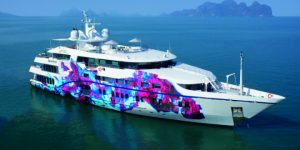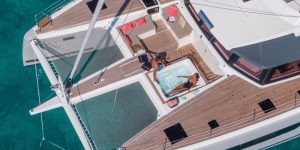Yacht industry in Indonesia: Paul Wheelan explores the growing luxury market and its future
Expert Paul Whelan discusses the future of Indonesia’s yacht industry, and how it has been evolving over the past few years

Raja Ampat Expedition, © Aman Photos
“Wonderful Indonesia”, “I AM in Bali”, “Land of Water”, “15,000 Islands to Explore”, “The 3rd Great Cruising Ground….”
These are just some of the catch phrases uses by the Indonesian Tourism Board and many others when describing Indonesia. It was only a matter of time before Indonesia moved on from a country that yachtsmen only dreamt of cruising to, but more often than not steered clear due to unclear regulations and some online horror story written by a hapless yachtsman many years ago.
Fortunately, the Indonesian government has recognised the benefits that yachting can bring to the country, and has made huge improvements to make it easier and faster for visiting yachts to clear into and cruise Indonesia. In fact, the new online clearance system is working remarkably well, and the old CAIT system is (almost) a thing of the past. This new system allows a visiting yacht to enter Indonesia and cruise for up to three years before needing to clear out of the country. This is fantastic news for visiting foreign yachts, and the number of cruising yachts visiting Indonesia has increased dramatically since the system’s implementation last year.
Great environmental progress has also been made with the creation of more than 100 Marine Reserves, including the largest in South East Asia located in the Savu Sea. This has created world class diving and cruising grounds in areas such as Raja Ampat among others.
Visiting yachts (both large and small), are certainly a great help in raising yachting awareness, and bring the economy much-needed funds. However, these visiting yachts are not enough to drive the yachting industry to a level where it will make a large and meaningful impact on the lives of Indonesians throughout the Archipelago.
So, what is needed to allow Indonesia to move to the next stage of yachting maturity and really live up to its name of one of the world’s great cruising destinations?A big step in the right direction will be the development of reliable infrastructure in the form of professionally built and
A big step in the right direction will be the development of reliable infrastructure in the form of professionally built and managed marinas, boat yards with the expertise and safety standards to work on today’s modern yachts, local technicians and crew with the required training and knowledge to operate and repair complicated onboard systems, along with service mentality, availability of spare parts and companies that are willing to stock them, and of course the co-operation of the government. There are no shortages of locals and foreigners willing to commit time and resources to make all of these things a reality, and that has certainly been happening in various parts of Indonesia. However, it’s a long and very winding road to achieve these lofty goals.
Most importantly, we need strong support from the government, and the various departments must work together to recognise the benefits of developing the yachting industry for both domestic and foreign-owned yachts.
Indonesia has a large and increasingly wealthy middle-class population that has the potential to drive large sales in the entry-level boating market, which will fuel generational growth into larger yachts and help develop a true boating culture.
Another proven way of introducing yachting to the local population and increasing marine tourism is through charter for both domestic and inbound guests. At present, the Indonesian charter fleet consists of locally built Phinisis ranging from luxurious to basic, and a mish-mash of older imported or locally built boats. The demand for high-quality charter boats is not being met, and Indonesia is losing customers to the more charter-friendly markets of Thailand, Malaysia and Australia. The local Indonesian boat building industry does not have the capacity to meet the demand for high-quality boats, and this leads to the prohibitive 75% luxury tax on importing boats for commercial use. Whilst this tax is in place, the gap between supply and demand will only grow, and a true yachting industry will struggle to emerge.
Fortunately, these issues are on the government’s radar, and it’s an area where the large pool of foreign yachting experience that is present in Indonesia can contribute and add immense value to ensuring the industry is developed in a way that is sustainable, protects the environment, and creates employment and investment opportunities for all parties.
At a recent meeting with the Marine, Customs, and Tourism Departments, these issues were discussed, and the need to improve the current system or risk falling behind our more progressive neighbours in SEA was clearly understood. Thankfully, many of these high-ranking officials are open to assistance from the industry and are willing to learn. However, to make a real difference, we need that same willingness to penetrate all layers of government throughout the archipelago. That will take time and a steady hand.
However large the obstacles may be, the future looks extremely bright. Indonesia is blessed with natural beauty and a patriotic population who is keen to see its country prosper. Furthermore, working together with the many dedicated foreigners who now call Indonesia home, will surely result in great things for this “Wonderful Indonesia.”
Paul Whelan

Australian born, Paul brings nearly 30 years of marine industry experience to Simpson Marine. He has hands-on experience in virtually all aspects of the industry, including boat building working on superyachts, management of marine businesses and sales.
A qualified Master Class IV Captain, Paul has logged extensive sea miles with multiple Transatlantic and Indian Ocean crossings, Mediterranean and Caribbean cruising and lengthy periods in Asia on board 60m+ yachts. Paul currently resides in Indonesia.
This article was written by Paul Whelan, and was first published in Issue 36 of Yacht Style









